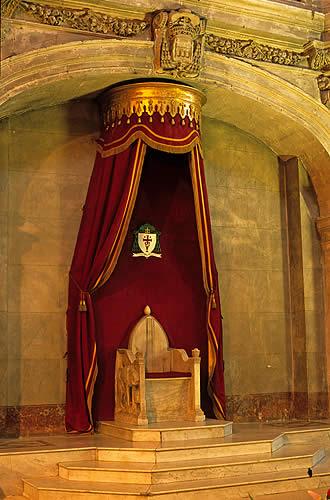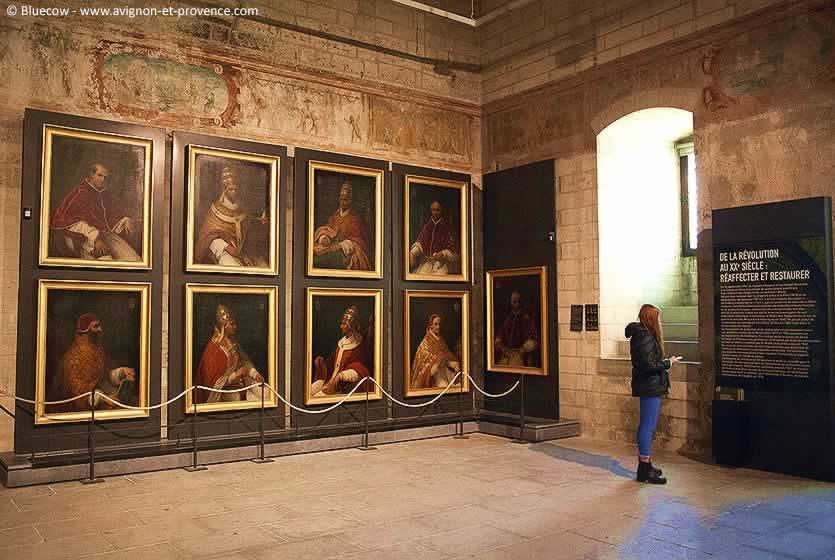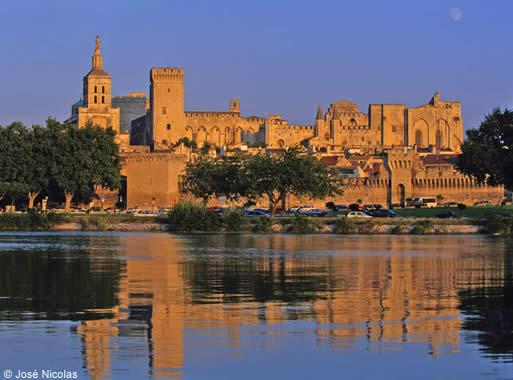

In the beginning of the 14th century Avignon recovered from the events of the preceding century. If she didn't recover the powerful rôle in the region to which she aspired the city did rapidly dress its wounds : the Saint Benezet bridge was repaired, and the outer ramparts were reconstructed. After some whimsical rebellions against Capetien authority, the Avigonnais seem to have become wiser for their troubles. The city counts a population of 4000 to 6000, which is a high number for the Middle Ages.
For a long time already, and certainly during the second half of the 13th century, the pope resided regularly outside of Rome. Innocent IV, for example, sojourned several years in Lyon between 1245 and 1251. When Pope Clement V came to Avignon in 1309, received by the Dominicans, he had no intention of establishing himself permanently, nor of creating a new Christian capital in Avignon. It was, nonetheless, the role that the city would play for a hundred years.
The choice of Avignon as a permanent residence was essentially the result of political considerations. The pope no longer wanted to stay in a Rome torn by rival clans, prey to constant riots and uprisings. After the schism between the eastern and western church, Rome found herself outside the center of Catholic Christianity, of which the kingdoms of France and England formed the two great and rival powers. Avignon lies adjacent to the County of Venaissin, church land since 1274. The city itself belonged to Charles II of Anjou, Count of Provence as well as king of Naples, making him a vassal and faithful ally of the pope. Pacified, Provence enjoyed a profound peace for half a century.
During the first period, from 1309 to 1376, six successive popes resided in Avignon: Clement V, Jean XXII, Benoit XII, Clement VI, Innocent VI et Urban V.. These 67 years radically transformed the city, and left a marked imprint, to which the city today owes its world renown.
The installation of the pope and his court provoked a tremendous increase in population. Avignon counted an estimated 40,000 inhabitants. This number, very elevated for the time, made Avignon one of the largest cities in Europe, and certainly the most cosmopolitan.


Construction of the celebrated Popes' Palace, a fortified palace of a colossal spread, began in 1335, under the pontificate of Benoit XII. At the time of his successor's, Clement VI, death, the palace was practically completed. All over the city and its environs, the cardinals had built sumptuous residences, each rivaling the other in magnificence and ostentation. The Petit Palais and the Livree Ceccano are beautiful examples; the latter now houses the municipal library. The city, transformed, adorns itself with gothic monuments : reconstruction, enlarging and embellishment of churches, monasteries and convents. The population overruns the now too tight city walls. In 1355, the pope decided to construct new bulwarks to protect against pillaging bands.
The prestige and pomp of the Avignon papacy reaches its peak under the illustrious pontificate of Clement VI (1342 - 1352 who bought the city from Queen Jeanne for 80,000 gold florins.
The second half of the 13th century was a troubled period. During the numerous truces during the Hundred Years War between France and England disengaged mercenaries formed the "Great Companies." For their own account they pillaged and massacred the villages, sowing terror wherever they went. Some came to Avignon, attracted by the concentration of wealth. In 1357 and 1358, the County of Venaissin was devastated, and Avignon dangerously menaced. To avoid this danger, the pope paid a ransom. The insecurity persisted, even with a second payment in 1360. In 1365, Bertrand de Guesclin, on his way to Spain at the head of a veritable army of despoilers, stopped in Villeneuve and demanded an exorbitant ransom, paid by Urban V. Along with these hordes, the Plague hit Europe. The epidemics decimated the population. The first, in 1348-49 was the worst. The city lost thousands to the plague. In 1361, it struck again, accompanied by famine.
The Pope Gregory XI, urged by the Romans and motivated by the disorder and revolts in the Pontifical states, returned to Rome on January 7, 1377, after 3 and a half months of an exhausting journey. He died there the following year on March 27, 1378.
The death of Gregory XI marked the beginning of another troubled period for the papacy. Under pressure of rioting Romans, the cardinals elected an Italian pope, who took the name of Urban VI. However, several among them, mostly French, considered the election null, and re-assembled to elect a new pope, Clement VII, who established himself in Avignon in 1379. The former had the allegiance of central and northern Italy, the Holy Roman Emperor, Flanders and the English king ; the latter of the Kingdom of Naples, France and Spain.
The Great Schism
The division of the Catholic Church into two subordinate groups lasted until 1409. Clement VII's successor, Benoit XIII would progressively lose his partisans, to the point of finding himself besieged in the Popes' Palace by the people of Avignon, remaining a virtual prisoner for 5 years. He escaped by a secret passage during the night of March 11 - 12, 1405. He died in 1409, protected by his last remaining supported, the king of Aragon. His nephew, Rodrigo de Luna defended himself in the palace for 17 months. He ordered the demolition of all the houses in front of the palace to prevent his adversaries from insinuating themselves into his stronghold. He thus formed the grand esplanade known today as the "Place du Palais".
Where to sleep?
Maison Chenet, Entre Vigne et Garrigue
165 EUR/night*
Bed and breakfast - Avignon and the surroundings
160 EUR/night*
Bed and breakfast - Avignon and the surroundings